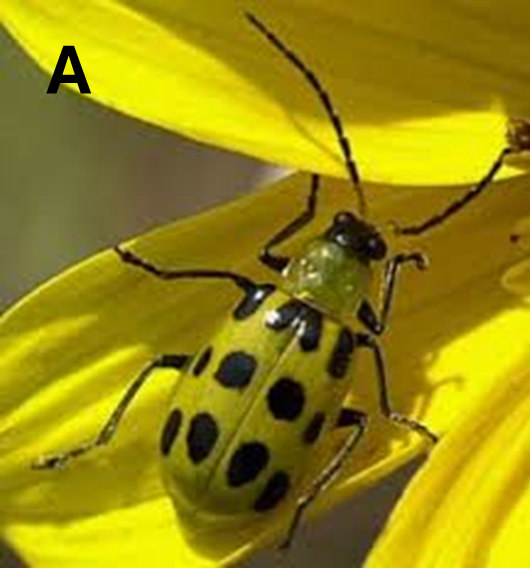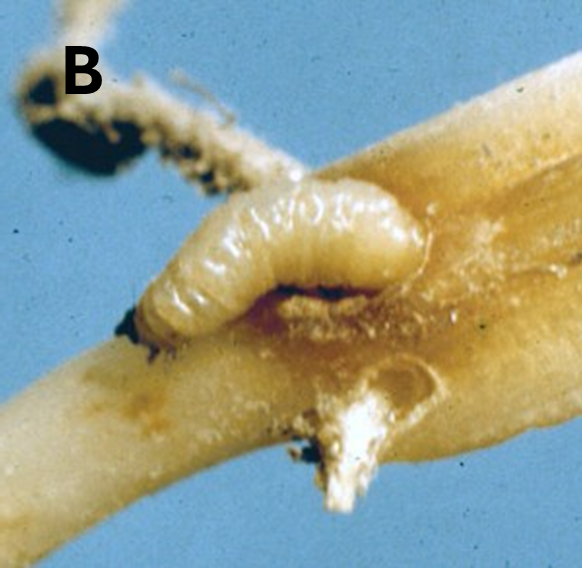Insect update in wheat plus beneficial and pest insects ready for crop rotation
Aphids and Wheat Head Armyworm in Wheat
The 2024 OSU Wheat Variety Tours have had a lot of insect activity across the state – not just pests, but also loads of beneficials. The tours kicked off in Walters and Altus, OK on April 22, 2024. In terms of insect pests, pressure has remained relatively low with regular observations of bird cherry oat aphids (BCOA) and English grain aphids. BCOA adults are dark olive green and have an orange spot on their abdomen (Figure 1). English grain aphid adults are lime green in color while long black legs and antennae, and black “tailpipes” (cornicles) on the tip of their abdomen (Figure 2) (nymphs or immatures may lack the black coloring). Both aphids are vectors of barley yellow dwarf (BYD) which is often transmitted by the aphid to the plant before aphid populations reach levels that warrant insecticide application (see OSU Extension webpage on BYD for more information on symptoms and control suggestions), so monitoring for these aphids during the wheat growing season is a good practice.
Figure 1. Bird cherry-oat aphid. (Photo: Richard Grantham, retired, Oklahoma State University)
Figure 2. English grain aphid. (Photo: Ashleigh M. Faris, Oklahoma State University)
In recent weeks, we are seeing populations of the English grain aphids on the rise in some locations. You may find these aphids tucked within in the wheat heads (Figure 3) and on weeds within and surrounding your fields (Figure 4). Some wheat producers may be alarmed by the increase in English grain aphids during the “head fill” stage with a concern for how the aphid may impact test weight. While Oklahoma does not have a specific economic threshold (ET) for this aphid, other states recommend an ET of 50-100 aphids/head on average or an ET of 100 aphids per linear foot of row when wheat is in head fill. The high number for these ETs should put many Oklahoma wheat producers at ease as it takes a high English grain aphid load to cause test weight issues during grain fill and aphid populations observed during the wheat tours are well below these numbers.
Figure 3. English grain aphids in wheat heads during soft dough. (Photo: Ashleigh M. Faris, Oklahoma State University)
Figure 4. English grain aphid adults and nymphs on “true” cheat, Bromus secalinus. (Photo: Ashleigh M. Faris, Oklahoma State University)
Wheat head armyworms (Figure 5) have been observed in Northwest Oklahoma. Fortunately, these are a minor pest in wheat. Wheat head armyworms are greenish, cream colored with longitudinal white and brown lines along the side of their body. This makes them difficult to detect when they feed on wheat heads during the cooler parts of the day, early morning and late evening. In the heat of the day, they can be found in the soil at the base of the plant. Wheat head armyworm damage can be classified as ‘IDK’ (insect damage kernels). Larvae will feed on the kernels and hollow them out, leaving damage like that caused by stored grain pests. However, justification for scouting these worms and spraying insecticide is low due to the wheat head armyworm’s typically sporadic and isolated infestations. Wheat head armyworms typically infest field margins, therefore producers with an infestation may find that baling the perimeter of the field and then harvesting the interior separately can reduce IDK concerns.
Figure 5. Wheat head armyworm. (Photo: Ashleigh M. Faris, Oklahoma State University)
Due to these pest numbers being below ET and with wheat harvest around the corner, the need for insecticide application is unlikely. To accurately determine the need for control, producers should have a good estimate of pest numbers, know the value of their crop, and know the cost of control. When applying any pesticide at this point in the season one needs to also keep in mind the preharvest interval (PHI). See OSU Fact Sheet CR-7194 “Management of Insect and Mite Pests in Small Grains” for more information on registered insecticides, application rates, and grazing/harvest waiting intervals.
Monitoring for Beneficial Insects
The good news about the presence of these aphids is that they’re attracting loads of beneficial insects such as lady beetles and larvae (Figure 6), green lacewing adults (Figure 7) and larvae, hover fly (syrphid) larvae (Figure 8), and parasitic wasps (Figure 9). All of these provide natural control of many agronomic insect pests, not only aphids. This is excellent news for those in double crop systems as these beneficial insects can be proactive in suppressing pest populations in crops that are and will be planted over the next month.
Figure 6. Lady beetle adult and larva in wheat. (Photo: Ashleigh M. Faris, Oklahoma State University)
Figure 7. Green lacewing adult and bird cherry oat aphid in wheat. (Photo: Ashleigh M. Faris, Oklahoma State University)
Figure 8. Hover fly (syrphid) larva in wheat. (Photo: Ashleigh M. Faris, Oklahoma State University)
Figure 9. Parasitic wasp. (Photo: Ashleigh M. Faris, Oklahoma State University)
When monitoring for insect pests one should also actively monitor for beneficial insects. The presence of beneficial insects should tip you off that there are likely insect pests in your field. For example, if you see lady beetles on wheat heads, then this may be an indicator for English grain aphids. Check the top and underside of leaves for beneficial insect eggs. These insects can lend to insect pest suppression, so keep that in mind the next time you reach for an insecticide to apply in your cropping system. Select one that is low impact on these natural enemies like cyfluthrin and avoid the use of broad-spectrum insecticides to keep beneficial insect populations flourishing. Beneficial insect populations can lag slightly behind insect pests, it is the pest’s presence that is driving the beneficials’ attraction, but the beneficial population can catch up and suppress the pest population.
Insect Pests to Monitor with Potential for Moving into Other Cropping Systems
As wheat harvest draws near, there have been other insect pests of note observed in wheat. It’s important to monitor for these insects as you rotate into other crops or leave your field fallow. These pests (and fortunately the beneficial insects) are in the environment and can readily move into neighboring and/or rotating cropping systems to take advantage of young, growing plants.
Stink bugs (Figure 10) are here! Although rarely damaging in wheat, they are in the environment and will readily move to other crops such as soybeans, cotton, sorghum, and corn where they can cause economic damage. These insects have a characteristic shield or 5-cornered shape. Adults and nymphs will feed by piercing the soybean pods, cotton bolls, developing sorghum grain, or the base of seedling corn plants with their slender mouthparts. Immatures look like adults but lack wings which form the “shield” in adults. Stink bugs will readily move between crops, grasses, and weeds so monitoring populations is important. Stink bugs can be monitored by sweep nets or drop cloths. For more information on how to survey and suggestions for control see OSU Fact Sheet CR-7167 “Management of Insect and Mite Pests in Soybean” and Texas A&M AgriLife Extension Cotton Insect Management Guide: Stink Bugs.
Figure 10. Stink bug in wheat. (Photo: Ashleigh M. Faris, Oklahoma State University)
Spotted cucumber beetles (Figure 11A) have been observed in wheat fields during the recent wheat variety tours. Adults are typically bright yellowish green with 12 black spots on their backs. Their larvae, corn rootworm, will bore into the stalk just above roots and kill young corn plants (Figure1B). These larvae are slender and yellowish white in color, they have a dark brown head and plate at the ends of their body. The plate at the posterior end has two short projections. Feeding damage by corn rootworm can result in lodged and “goosenecked” plants. Damage by the southern corn borer is most common in seasons of cooler and wet weather, especially in low lying areas of fields, and will likely occur early in the growing season (before June 15). Because the beetle lays eggs in the soil after corn is in the seedling stage, crop rotation alone is not enough for control of this pest. Seed treatments or in-furrow pesticide applications are a worthwhile investment, especially in cases where stand counts have been reduced by previous infestations. For more details on corn rootworm control see OSU Fact Sheet CR-1792 “Management of Insect and Mite Pests in Corn”.
| Image | Caption |
|---|---|
 |
Figure 11A. Spotted cucumber beetle. |
 |
11B. Corn rootworm. (Photos: Oklahoma State Extension, Oklahoma State University) |
Active monitoring, following economic thresholds (ETs) while considering the natural control in your fields and surrounding habitat will allow you to make the best pest management decisions. Contact your county educator for assistance in insecticide recommendations.
References
Bailey, W.C. Aphid Populations Present in Wheat. Integrated Pest and Crop Management. University of Missouri Plant Science and Technology. https://ipm.missouri.edu/cropPest/2011/4/Aphid-Populations-Present-in-Wheat/#:~:text=Economic%20threshold%20of%2012%2D25,emergence%20up%20to%20head%20emergence. Accessed: May 10, 2024.
Johnson, D.W. and L. Townsend. (n.d.) Chapter 8: Insect Pests in A Comprehensive Guide to Wheat Management in Kentucky. University of Kentucky Cooperative Extension Service. https://www2.ca.uky.edu/agcomm/pubs/id/id125/08.pdf. Accessed: May 10, 2024.
Koch, R.L., D.T. Pezzini, A.P. Michel, T.E. Hunt. (2017) Identification, Biology, Impacts, and Management of Stink Bugs (Hemiptera: Heteroptera: Pentatomidae) of Soybean and Corn in the Midwestern United States, Journal of Integrated Pest Management, 8:1. https://doi.org/10.1093/jipm/pmx004
Michaud, J.P., P.E. Sloderbeck, and R.J. Whitworth. (2007) Wheat Insects: Wheat Head Armyworm, Faronta diffusa. Kansas State University Extension, Field Crop Protection. https://entomology.k-state.edu/extension/crop-protection/wheat/wheat-head-armyworm.html. Accessed May 20, 2024.
Porter, P., E. Bynum, R.D. Parker, R. Bowling, and S.P. Biles. (n.d.) Southern Corn Rootworm on Corn – Pre-emergence Stage. Texas A&M AgriLife Extension. https://extensionentomology.tamu.edu/2016/07/22/southern-corn-rootworm-on-corn-pre-emergence-stage/. Accessed: May 14, 2024.
Texas A&M AgriLife Extension (n.d.) Cotton Insect Management Guide Stink Bugs. Texas A&M AgriLife Extension. https://cottonbugs.tamu.edu/fruit-feeding-pests/stinkbugs/ Accessed: May 14, 2024.










